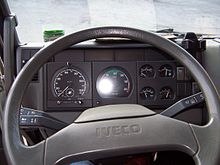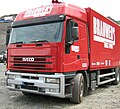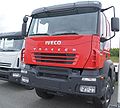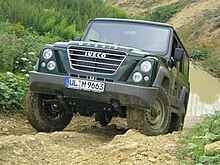Iveco
| Iveco SpA
|
|
|---|---|
| legal form | Società per Azioni |
| founding | 1975 |
| Seat |
Turin , Italy |
| Branch | Commercial vehicles , military vehicles , engines |
| Website | www.iveco.com |
Iveco ( acronym for Industrial Vehicles Corporation ) is an Italian commercial vehicle manufacturer founded in Turin in 1975 . The company is now part of CNH Industrial .
overview
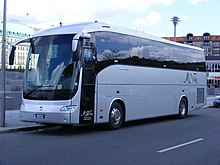

Iveco was formed in 1975 as a merger of the truck division of Fiat , the Italian truck manufacturer OM (Officine Meccaniche) , the French truck manufacturer Unic and the German Magirus-Deutz AG under the leadership of the Fiat Group, to which the new company holds 80% belonged to. Initially, the German company Klöckner-Humboldt-Deutz AG (KHD) (the former parent company of Magirus-Deutz) held the remaining 20% of the shares in Iveco; However, these also went to the Fiat group in 1980, which has been the sole owner since then. As early as 1975, the commercial vehicle division of the Fiat manufacturer Lancia , which had already become insignificant, was incorporated into the new Iveco. In 1986 the truck division was taken over by Alfa Romeo .
The core areas of production are vans , light to heavy trucks for local and long-distance traffic, buses , construction vehicles and fire engines . The production of diesel engines for various areas is also part of Iveco's activities. Iveco is the second largest manufacturer of trucks in Europe (market share approx. 20%) and the largest manufacturer of diesel engines worldwide. Production is around 200,000 commercial vehicles and 460,000 diesel engines per year. In addition to trucks, in which 40% of the engines are installed ( Tector , Cursor ), tractors and vehicles from other manufacturers ( SOFIM ), they are used, for example, as industrial engines, marine engines and drives for emergency power generators ( Turin-8000 , Pregnana-Milanese ) . Iveco operates 49 factories and 15 development departments worldwide and employs 31,000 people. The sale took place in 19 countries (as of 2005). In the fire protection area, the name Magirus of the Iveco subsidiary Iveco Magirus is known worldwide. Iveco is (by its own account) the largest manufacturer of turntable ladders in the world.
Important dates in the company's history
- 1974: Klöckner-Humboldt-Deutz AG (KHD) and the Fiat Corporation agree on a cooperation in the commercial vehicles sector, Iveco AG ( I ndustrial Ve hicles Co rporation) is first founded by Fiat alone.
- 1975: KHD brings its commercial vehicle activities into Iveco in the form of Magirus-Deutz AG and receives a stake of 20% in the new Iveco AG.
- 1976: Establishment of the Libyan joint venture Trucks and Bus Company
- 1980: KHD sells its Iveco shares to Fiat.
- 1982: Foundation of a joint venture with Adolph Saurer AG for engine development
- 1982: Closure of the Magirus-Deutz bus plant in Mainz and discontinuation of the bus division in Germany
- 1983: Renaming of Magirus-Deutz AG to Iveco Magirus AG
- 1985: Joint venture with the Ford UK Truck Division
- 1986: Complete takeover of Ford Truck UK
- 1987: Takeover of Astra
- 1989: Iveco Magirus AG celebrates 125 years of the Magirus brand.
- 1990: Iveco takes over the remaining shares in the joint engine development Saurer / Iveco
- 1990: Integration of Pegaso (and its subsidiary Seddon Atkinson ) into the Iveco group
- 1992: Takeover of International Trucks Australia Ltd.
- 1996: Iveco founds a joint venture with NAC ( Nanjing Automobile Group ) in China under the name Naveco .
- 1997: Foundation of Iveco Mercosul in Brazil , which takes over truck production for South America
- 1997: Langley plant closes and production in Great Britain ceases
- 1999: Iveco and Renault Vehicules Industrielles (RVI) found the joint subsidiary Irisbus , in which the bus activities of both manufacturers are combined.
- 2003: Acquisition of Renault's shares in Irisbus, Iveco becomes the sole owner
- 2006: Further cooperation agreements between NAC and Iveco Italy
- 2007: Cooperation between Iveco and SAIC (Shanghai Automobile Industry Cooperation Group) in China
- 2007: Iveco plans a cooperation with the largest Indian commercial vehicle manufacturer Tata Motors .
- 2011: Fiat spins off the entire commercial vehicle division (including construction and agricultural machinery). Together with CNH (Case / New-Holland), Iveco is listed on the Milan stock exchange as Fiat Industrial .
- August 3, 2012: Truck production in Ulm ends.
Structure of the company when it was founded
In 1975 the following commercial vehicle manufacturers joined forces to form Iveco:
- Fiat Veicoli Industriali SpA ( Turin / Italy )
- Lancia Veicoli Speciali SpA ( Bozen / Italy )
- OM (Officine Meccaniche) ( Brescia / Italy )
- UNIC SA ( Puteaux / France )
- Magirus-Deutz AG ( Ulm / Germany )
Later acquisitions
The following manufacturers were later taken over by Iveco:
- Takeover with later abandonment of the name:
- Ford Europa ( GB ) (brand name abandoned in Europe as a truck manufacturer)
- Engine development by Adolph Saurer AG ( Switzerland ) (brand name for trucks abandoned, but this did not go to Iveco)
- ENASA / Pegaso ( Spain ) (brand name abandoned as truck manufacturer)
- Takeover with continuation of the name until today:
- Spin-off under a new name and later takeover:
- Irisbus ( Saint-Priest / France ) (created in 1999 as a merger of the bus divisions of Iveco and Renault Vehicules Industrielles (RVI) as well as other affiliated manufacturers, completely taken over by Iveco in 2003; since 2013 as Iveco Bus )
- International Trucks Australia (local version of US company International Harvester / Navistar )
Iveco was also the initiator of the Eurofire group of companies, which consisted of the following companies:
- Iveco Magirus Brandschutztechnik GmbH with plants in Ulm , Weisweil and Görlitz (Germany)
- Lohr-Magirus fire fighting technology in Kainbach (Austria)
- Iveco Mezzi Speciali in Brescia (Italy); formerly: Baribbi
- Eurofire-Camiva in Chambéry (France).
Since 2005, Iveco’s fire protection activities have been grouped under the umbrella brand Iveco Magirus, which consists of the individual brands Magirus, Lohr-Magirus and Camiva. The names Eurofire and Iveco Mezzi Speciali were given up.
Iveco commercial vehicles
Development from 1975 to 1992: the old brands growing together
Since the assortments of the predecessor companies included quite modern truck models when Iveco was founded, the model range of the Iveco brand initially consisted of a selection of those vehicle types that came from these individual companies that had merged into Iveco. From now on, these models were offered throughout the group, in the respective home countries of the various original brands initially while retaining the previous name (in France for example as UNIC and in Germany as Magirus-Deutz) with an initially rather inconspicuous and small addition " Iveco ". In the early years, Iveco vehicles still bore the old brand names clearly on the radiator, however, as a sign of affiliation with the new company, the Iveco logo of the time (a stylized lowercase letter "i", embedded in the name "Iveco") ). However, compared to the previous models offered by the predecessor, a partial type adjustment took place, for example the X series from OM replaced the light Eicher types from Magirus-Deutz in Germany .
The individual samples taken over are:
- light trucks of the X series, which was further developed by OM in the early 1970s on the basis of older predecessor types . These were later sold as Iveco (Turbo) Zeta in the weight class of 5 to 8 tons total weight and thus covered the market from large vans to light distribution trucks. This series remained in the program until the introduction of the first Iveco EuroCargo in 1992.
- the light to medium-weight MK series , which was the Magirus-Deutz version of the so-called four-club vehicle. This model was only released by Magirus-Deutz in 1975 and was also included in the Iveco range. It was also built until the introduction of the Iveco EuroCargo in 1992. The MK series initially ranged from 6.6 to 13 tons total weight, but the lighter models were discontinued a little later due to the overlap with the X series.
- the medium to heavy corner hoods from Magirus-Deutz (the "construction bulls"), launched in 1971. These were mainly used as construction vehicles and met the demand for total weights between 13 and (most recently) 33 tons. In the end, this model series did not expire as the Iveco PA series for the German market until 1993; for foreign markets, the heavy hoods were offered until 2003.
As far as the heavy trucks are concerned, UNIC had previously been a Fiat assembly plant under its own name and so did not bring its own model into the network.
The situation differed in the early years of Iveco for the medium and heavy forward control models with a gross vehicle weight of 14 tonnes or more . The heavy long- haul trucks from the former Fiat range were initially built under the new name . B. Type 160 NC, which had previously been identical under the names OM and UNIC. For example, these were also sold in Germany through its own dealer network under the name Fiat until 1977. Up to this point in time, the old D-series long-distance transport models from Magirus-Deutz were still available as the only heavy forward control vehicles in Germany, which still featured the cubic TE cab ( T rans E uropa) with the distinctive step , which dates back to 1963 in the roof.
In 1977, although in accordance with the agreed division of labor, the development of the heavy models had been taken over by the Magirus plant in Ulm since Iveco was founded, new medium and heavy front control vehicles with medium-length (this version was previously missing in the Magirus-Deutz range) and long long-distance driver's cabs were introduced the market, which were technically and visually based on their predecessors from the Fiat range. These models were initially named M series . The cabs, like those from Fiat before, were much more rounded than those of the German predecessors or the still quite new MK series. The engines were also adopted or further developed by Fiat. This was obvious because within the Iveco only the machines from the Fiat shelves were water-cooled, which was already common practice in long-distance transport in Europe at that time, while Magirus-Deutz at that time still exclusively relied on the air-cooled machines traditionally installed there Engines had set. The wide range of air-cooled engines from Magirus-Deutz was in turn included in the new Iveco model range and was now offered on request within the entire group of companies, conversely, the water-cooled machines from Fiat and OM were also available in the former Magirus-Deutz models , so that in this respect Iveco was the only Western European manufacturer to "go two ways" over the next few years.
At the same time as the new M series, the older Fiat trucks were also built in Italy until the 1980s. The former Magirus-Deutz long-distance transport models were quickly replaced by the new types, but the last model with the old TE long-distance cab was not removed from the range until 1981. Since the M-series cabs were not initially available as very short versions in Germany, the heavy local transport models continued to be built with the cubic D-cab from Magirus-Deutz until 1983, fire engines and comparable vehicles for other organizations such as DRK or THW kept it even until 1987.
IVECO T series as Magirus-Deutz (Magirus logo missing)
IVECO T series as IVECO-Fiat
In 1978, the Iveco Daily appeared as a small van, rounding off the range . It was initially developed by Fiat, Alfa Romeo and OM and also manufactured by OM and initially sold as Fiat. In 1980 it appeared on the German market as Iveco, but from 1983 it was only offered under this name. The Daily has the oldest product name still in use and has been in the range since 2014, now in its sixth generation.
From 1982, the new Iveco brand was visually much more present: The clearly legible Iveco lettering was now emblazoned on the radiator grille in the center of the vehicle, while the previous individual brands were only identified with a small lettering on the side. The more tradition-conscious customers were slowly introduced to the new brand. From the mid-1980s onwards, the old names were no longer used, only the name Iveco remained. Only the truck brand OM had already disappeared in 1980.
Iveco 90-16 ( four-man club vehicle of the MK series taken over from the Magirus-Deutz range)
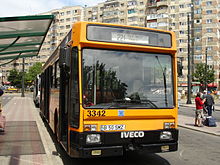
Also in 1982 bus production in Germany was discontinued and the bus plant in Mainz-Mombach was closed, after the models had been successively changing their names in the same way as the trucks and finally even received the large Iveco lettering. The standardized regular-service buses for the German market had been retained from the former Magirus-Deutz range until then, while the older touring coaches of the TR series had given way to the M 2000 model, which came from the Fiat Group and was also built exclusively in Italy , which was dropped from the local program in 1982 with the end of bus production in Germany. The smaller R 81 club touring coach, which also came from the Magirus-Deutz legacy, had been adapted to the design of the new M 2000 in 1978 and had since been given new turbo-charged engines. This model also expired when the factory closed in 1982. In Italy, where Iveco was very strong in bus and coach construction, production continued unchanged. It was not until the mid-1990s that Iveco touring coaches were on offer again in Germany, although these played almost no role. Only minibuses based on the Italian-built Iveco Daily and Turbo-Daily have remained in the program to this day.
1984 appeared as the new top model of the long-distance transport models, which have now been converted to the T series, the TurboStar , including the TurboTech model for long-distance transport . The TurboStar was considered to be very well equipped for its class and had a comfortable cab, which was usually crowned by a standard wind deflector on the roof. The Turbo-Tech was the normal version, its house was 18 cm narrower than the top model. Both new vehicle types were only available with water-cooled turbo engines. The other vehicles of the T-series as well as the MK-types had to make do with alphanumeric or later purely numeric model names. The T-models below were also initially available as long-haul trucks with 260 and 300 hp, TurboTech and TurboStar with 320 and 360 hp, only the TurboStar also with 380 and 420 hp.
With the further development of the long-haul trucks to the T-series, the construction vehicles were given the designations P-series for forward control, whose design corresponded to that of the weaker T-models, as well as PA for the heavy hooded trucks from the Magirus-Deutz legacy, which are still in the range . Both were available with both conventional and all-wheel drive , and there was also an all-wheel drive model from the MK series (e.g. the 130M7FAL). However, at the end of the 1970s, this was not so much developed with a view to construction site use as a basis for military vehicles , as an all-wheel drive version was also required in tenders for army trucks. The MK models, but mainly as conventionally powered military trucks, became very popular with the German armed forces, for example , while the civil all-wheel drive MK remained an exotic one. The old hood models were also only sold in small numbers despite modernized technology (including the current turbo engines with up to 300 hp). The heavy forward control construction vehicles of the P-series, however, still sold very well. In the end, they were available with up to 340 hp and, in addition to the well-known two- and three-axle vehicles, now also in Germany as a four-axle tipper and concrete mixer after the approval regulations were changed .
Development from 1992 to 2002: complete renewal of the commercial vehicle range
There were continuous technical developments in the following years, but it was not until 1992 that the truck range was completely renewed in a relatively short period of time, which was unprecedented in the European commercial vehicle industry. The EuroCargo started as a lighter distribution truck (especially in the 7.5-tonne class) that replaced the old MK series as well as the larger models of the light Zeta series (which became the smaller models of the Zeta series replaced by the heavier models of the Daily Transporter). Likewise, the Euro-Cargo in Great Britain replaced the Ford Cargo, which was last built there as Iveco-Ford and is still popular, but only became a few there due to the Ford name, which is also very well known in the truck sector, as well as the new, more powerful models Years sold under the double name Iveco-Ford. The spectrum of the Euro-Cargo ranged from 6.5 to 15 tons total weight.
In 1993, the EuroStar long-haul truck appeared , which based on the name of the previous top-of-the-range Turbo-Star model formed the upper class of the new model series, as well as a medium and heavy distribution and long-haul truck from Euro-Tech with a smaller driver's cab. In the same year, with the introduction of the Euro-Trakker, derived from the Euro-Tech series, as an all-wheel drive and construction vehicle, the entire forward control range of the 1980s with the cab of the T series disappeared, as did the last ones still on Magirus. Deutz declining hooded cars ran out this year, at least for the German market (for foreign markets, the heavy hooded cars were still available until at least 2003).
Although a visual standardization of the various models had already been formulated when the company was founded, it was only now that all new models were given a very similarly styled family face that was previously unknown at Iveco. The new models have cabs with clear symmetrical contours and several horizontally running cooling air openings at the front (three each for Euro-Cargo and Euro-Tech, five for the Euro-Star). The air-cooled engines from the Magirus-Deutz legacy had also disappeared from the range due to low demand, so that the engines also offered a uniform range. The air-cooled units were most recently found in heavy construction vehicles and fire engines.
While the vehicles for the construction sector had traditionally been a strong mainstay since Magirus-Deutz times, this area fell significantly behind the competition in the following years and has not regained its former importance to this day.
Outwardly unchanged, the new models remained in the range for almost ten years, until the vehicles that are still current today came out in 2002, but under the sheet metal a large part of the technology changed during these years. The heavy vehicles had been equipped with disc brakes on the front axle since the model change. From 1997 onwards there was a major technical innovation for this as an alternative to the conventional manual gearbox, the semi-automatic gearbox called Euro-Tronic for heavy road trucks. In 1998 the Cursor 8 engines with a range from 240 to 350 hp appeared for the medium-sized Euro-Tech models . In the following year, the Cursor -10 units with 390 and 430 hp appeared for the more powerful Euro-Tech and Euro-Star vehicles . In 2000, the Tector engines between 130 and 210 hp followed for the Euro-Cargo . Finally in 2001, when the new models were already in the starting blocks, the large Cursor -13 machines with 380 to 540 hp followed. These engines went seamlessly into the truck models, which were visually renewed in 2002.
In 1995 the big buses gave a short guest appearance in the German Iveco program. This year, the Euro-Class models appeared as a normal touring coach and high-decker, and the Euro-Rider exclusively as a high-decker. However, these vehicles remained completely insignificant on the German market. After the bus activities were spun off into the Irisbus Group in 1999, they were soon replaced by coach types from Renault. Since then there have only been minibuses from Iveco, also from various third-party coachbuilders based on the Iveco Turbo-Daily.
Further development until today and current models
In 2006 the fourth generation of the Daily was launched. The fire protection technology plant of Iveco Magirus was relocated at the beginning of 2007 from the old location in Ulm's Magirusstrasse to the Iveco plant in the Donautal industrial area. There it takes up a large part of the former cab factory, with the cab assembly and interior fitting taking place there again since 2006. The cab production in the Danube valley was relocated to the Iveco plant in Brescia in 1997, but was partly brought back to Ulm in 2006. Since then, only the painted raw cabins have been delivered from Brescia. At the beginning of 2007 the Stralis was revised and is now offered in the new version. In 2008, after a long break, an Italian off-road vehicle, the “Iveco Massif”, was brought onto the market again.
In May 2012, various media reported that Iveco Magirus intends to close its heavy-duty truck production in Ulm and relocate it to Madrid. To this end, the fire protection center is to be expanded and capacities are to be relocated from other locations to Ulm.
Daily
The Iveco Daily is a small van with a total weight of 3.5 to 7 tons. The sixth generation of the model has been on the market since 2014. The Daily has also been available as an all-wheel drive version since 2008. This is a development of the off-road vehicle manufacturer SCAM, which was taken over in 2007, and is also manufactured by them. Technically, the all-wheel-drive Daily has little in common with the two-wheel drive versions, especially the completely different frame structure that sets it apart.
Eurocargo
The Iveco Eurocargo (written in one word since the revision) is the light to medium range from Iveco. It currently covers total weights from 6.5 to 18 tons and is usually found as a local transport and distribution truck as well as a construction site vehicle, but is also available with a simple sleeping cabin. The second generation has been available since 2003. What is less well known is that the Eurocargo is also offered in a 4 × 4 variant. In addition to Massif, Daily and Trakker, Iveco offers a fully off-road vehicle in every category.
Stralis / Stralis HI-WAY
The Iveco Stralis is the heavy series from Iveco. It represents the further technical development of the previous Euro-Tech and Euro-Star models, the origin of which can still be seen on the driver's cab. The Stralis appeared in 2002. The AS model (successor to the Euro-Star) is intended for heavy long-distance transport. There is also a version as a heavy distributor (AT) and a smaller long-distance truck with a smaller cab as an AT model. In 2006 the model received an extensive facelift . In 2013 Iveco revised the Stralis again and renamed it. As “Stralis HI-WAY” it was named Truck of the Year that same year. In 2016 the new Stralis models XP and NP were presented. The IVECO Stralis XP, also called TCO 2 CHAMPION from IVECO, has significantly reduced fuel consumption. With the IVECO Stralis NP, IVECO is the first manufacturer to make long-distance transport suitable for natural gas.
Trakker
The Iveco Trakker is the off-road version of the Stralis AT or the previous Euro-Tech and is technically closely related to them. All heavier all-wheel drive vehicles are sold as Trakkers, construction vehicles, both dump trucks and cement mixers, are also available as Trakkers without all-wheel drive.
Massif
The Iveco Massif is an off-road vehicle that was offered with two different wheelbases and three different body versions. The Iveco Massif model series was developed from the Santana PS-10 , for which Iveco has already supplied the engines. The Massif is thus related to the Land Rover Defender .
The Iveco Massif is a robust all-wheel-drive vehicle, the development of which focused on professional off-road missions for the military.
The Massif is available with a long wheelbase (2768 mm) as a five-door station wagon, as a platform truck and single cabin, and with a short wheelbase (2451 mm) as a three-door station wagon. All versions are available with left and right hand drive.
The Massif has a climbing ability of more than 100%, slope angles of 50 ° at the front and 30 ° at the rear and a ramp angle of 28 and 152 °. The fording depth with standard equipment is 500 mm, the ground clearance with standard wheels and tires is 200 mm. The all-wheel drive can be switched off and thus significantly reduces consumption due to the free-running front axle. Three equipment lines are available for the Massif: Classico, Montagna and Avventura.
Production ended in 2011.
Iveco bus
All current bus models are marketed under the Iveco Bus brand, from the Iveco Daily minibus to the Iveco Magelys coach .
An overview of the model history
| Timeline of Iveco trucks offered in Germany since 1975 | |||||||||||||||||||||||||||||||||||||||||||||||||||||||
|---|---|---|---|---|---|---|---|---|---|---|---|---|---|---|---|---|---|---|---|---|---|---|---|---|---|---|---|---|---|---|---|---|---|---|---|---|---|---|---|---|---|---|---|---|---|---|---|---|---|---|---|---|---|---|---|
| Weight class | 1970s | 1980s | 1990s | 2000s | 2010s | 2020s | |||||||||||||||||||||||||||||||||||||||||||||||||
| 5 | 6th | 7th | 8th | 9 | 0 | 1 | 2 | 3 | 4th | 5 | 6th | 7th | 8th | 9 | 0 | 1 | 2 | 3 | 4th | 5 | 6th | 7th | 8th | 9 | 0 | 1 | 2 | 3 | 4th | 5 | 6th | 7th | 8th | 9 | 0 | 1 | 2 | 3 | 4th | 5 | 6th | 7th | 8th | 9 | 0 | 1 | 2 | 3 | 4th | 5 | 6th | 7th | 8th | 9 | |
| Off-road vehicle | Massif | ||||||||||||||||||||||||||||||||||||||||||||||||||||||
|
Vans and small trucks |
Daily I. | Daily II | Daily III | Daily IV | Daily V | Daily VI | Daily VII | ||||||||||||||||||||||||||||||||||||||||||||||||
| X series, (turbo) zeta | |||||||||||||||||||||||||||||||||||||||||||||||||||||||
| Light to medium-weight trucks |
EuroCargo I | Eurocargo II | Eurocargo III | ||||||||||||||||||||||||||||||||||||||||||||||||||||
| MK series (club of four vehicles) | |||||||||||||||||||||||||||||||||||||||||||||||||||||||
| Medium to heavy trucks |
D series | ||||||||||||||||||||||||||||||||||||||||||||||||||||||
| M and T series , TurboTech , TurboStar | EuroStar , EuroTech | Stralis I | Stralis II | Stralis hi-way | S-Way | ||||||||||||||||||||||||||||||||||||||||||||||||||
| Construction vehicles | P series | EuroTrakker | Trakker I. | Trakker II | |||||||||||||||||||||||||||||||||||||||||||||||||||
| “Baubullen” hooded wagon, PA series | |||||||||||||||||||||||||||||||||||||||||||||||||||||||
| In 1975 the commercial vehicle manufacturers Fiat , Lancia , OM , Unic and Magirus-Deutz went into Iveco . The table shows the following colors: | ||||
| models taken over from Magirus-Deutz | models adopted from OM | models derived from Fiat models | models derived from Santana models | models developed by Iveco itself |
Iveco military vehicles
Combined under the Iveco Defense Vehicles division, Iveco offers military vehicles. The Iveco LMV military off-road vehicle has been manufactured since 2004 . Militarized versions of Iveco and Astra truck models are also available.
Iveco Trakker as a tank truck for the German armed forces
Web links
Individual evidence
- ↑ Archive link ( Memento from May 21, 2014 in the Internet Archive )
- ↑ http://www.swr.de/nachrichten/bw/-/id=1622/vv=teaser-12/nid=1622/did=9689392/78zdbg/index.html
- ↑ LSW: Iveco closes truck production in Ulm. In: FAZ.net . May 7, 2012, accessed October 13, 2018 .
- ↑ http://www.augsburger-allgemeine.de/neu-ulm/Iveco-schliesst-Lastwagen-Produktion-id19965006.html
- ↑ Iveco Defense Vehicles













